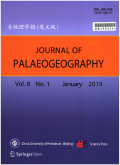- 钛学术文献服务平台 \
- 学术期刊 \
- 基础科学期刊 \
- 天文学、地球科学期刊 \
- 古地理学报(英文版)期刊 \
A radical reinterpretation of the growth and form of the stromatolite Conophyton lituus(Maslov)from evidence of syngenetic biofilm mineralisation
A radical reinterpretation of the growth and form of the stromatolite Conophyton lituus(Maslov)from evidence of syngenetic biofilm mineralisation
基本信息来源于合作网站,原文需代理用户跳转至来源网站获取
摘要:
Conophyton(Maslov)is a cylindroidal stromatolite form-genus characterized by nested conical laminae.Well-preserved Conophyton,up to 4 m tall and with basal diameters of up to 50 cm,are exposed in the Proterozoic Atar Formation of Mauritania,where many occur together,in growth position,as fields of individual columns spaced between 5 and 70 cm apart.The uniformity of these forms and their regular dis-tribution suggest that they grew in quiet-water environments below wave base.Evidence for their pene-contemporaneous organomineralization is indicated by nearby toppled examples of undeformed Conophyton forms alongside eroded lithified Conophyton fragments in carbonate breccias.Two characteristics of Con-ophyton have been used to classify the structures-the form of the lamination and the nature of its axial structure.A mathematical/physical model provides an explanation for the growth pattern of Conophyton.It predicts that coniform structures with thickened axial zones form when upward organic growth of a biofilm moderately exceeds the rate of its mineralization.The varying characteristics of these features between different forms of Conophyton are thought to reflect biomineralization of the decaying biofilm rather than differences in the composition of microbial communities.A modern example of a syngenetic mineralization process capable of producing similar structures has been observed in the contemporary sediments of Lake Preston,Western Australia,where benthic microbial mats are being transformed into coniform lithified crusts.The initial biomineralization of the coniform mat forms magnesium silicate that first coats and permineralizes web-like microbial extracellular polymeric substances(EPS)and then coalesces into a uniform mass that provides mechanical strength to the cones.At a later stage,massive carbonate crystal growth occurs that over-prints much of this texture,leaving only small,remnant areas of the magnesium silicate phase.Many fossil Conophyton are composed of dolomite,and the remains of the microbial communities responsible for their construction are rarely found,except in areas of chert within the Conophyton.It is suggested that Proterozoic Conophyton were constructed in a tranquil environment through the accretion of microbial mats that were syngenetically permineralized by a magnesium silicate such as a smectite.Later,much of the un-stable smectite would be susceptible to diagenetic replacement by either dolomite,or chert in which rem-nants of microbes that had been coated or permineralized could,potentially,be preserved.

推荐文章
Genesis of the Nanyangtian scheelite deposit in southeastern Yunnan Province, China: evidence from m
Fluid inclusion
C–O isotopes
Skarn
Scheelite deposit
Nanyangtian
Evidence from iron and manganese c
Carbonate rocks
Fe content
Mn content
Oxygen fugacity
Benthic flux
Ore genesis of Badi copper deposit, northwest Yunnan Province, China: evidence from geology, fluid i
Badi copper deposit
Fluid inclusion
Sulfur isotope
Hydrogen and oxygen isotope
Ore genesis
The metallogenic environment of the Dounan manganese deposit, Southeast Yunnan, China: evidence from
Dounan manganese deposit
Metallogenetic environment
Mössbauer spectroscopy
Geochemistry
内容分析
关键词云
关键词热度
相关文献总数
(/次)
(/年)
文献信息
| 篇名 | A radical reinterpretation of the growth and form of the stromatolite Conophyton lituus(Maslov)from evidence of syngenetic biofilm mineralisation | ||
| 来源期刊 | 古地理学报(英文版) | 学科 | |
| 关键词 | |||
| 年,卷(期) | 2022,(1) | 所属期刊栏目 | Biopalaeogeography |
| 研究方向 | 页码范围 | 69-84 | |
| 页数 | 16页 | 分类号 | |
| 字数 | 语种 | 英文 | |
| DOI | |||
五维指标
引文网络
引文网络
二级参考文献 (0)
共引文献 (0)
参考文献 (0)
节点文献
引证文献 (0)
同被引文献 (0)
二级引证文献 (0)
2022(0)
- 参考文献(0)
- 二级参考文献(0)
- 引证文献(0)
- 二级引证文献(0)
引文网络交叉学科
相关学者/机构
期刊影响力
古地理学报(英文版)
主办单位:
中国石油大学(北京)和科学出版社
出版周期:
季刊
ISSN:
2095-3836
CN:
10-1041/P
开本:
大16开
出版地:
北京市海淀区学院路20号中国石油大学
邮发代号:
创刊时间:
2012
语种:
eng
出版文献量(篇)
264
总下载数(次)
0
总被引数(次)
420
期刊文献
相关文献
推荐文献
- 期刊分类
- 期刊(年)
- 期刊(期)
- 期刊推荐

 免费查重
免费查重










